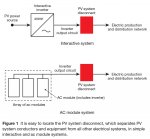electrofelon
Senior Member
- Location
- Cherry Valley NY, Seattle, WA
- Occupation
- Electrician
Up for discussion is the following: What exactly is a "Photovoltaic disconnect" ? I think it depends on the context. Consider a typical supply side connection with a safety switch. Most people would call that the PV disconnect. Many utilities require a "PV disconnect" which could be separate from any NEC disconnects. 690.13 seems to be what we commonly call the "DC disconnect" (usually built in to an inverter) and the "official" Pv disconnect right? Is the 690.13 disconnect what 690.56(B) is referring to? Then we have the disconnects in 690.15 which is, in practice, the "AC disconnect" and the DC disconnect in the inverter. I see lots of inconsistency with this in the field.
Consider the following situation: I have a remote meter pedestal utilizing 230.40 exception #3 with a set of SEC to the house and a second set to a detached structure with a PV system on in. The inverters are on the second floor and have integral DC disconnects and a AC combiner panel next to them. The combiner panel feeder connects load side to the service panel via backfed breaker. There is also a utility required safety switch disconnect on the outside of the building that breaks the feeder to the combiner panel. How would you classify the various disconnects here?
Consider the following situation: I have a remote meter pedestal utilizing 230.40 exception #3 with a set of SEC to the house and a second set to a detached structure with a PV system on in. The inverters are on the second floor and have integral DC disconnects and a AC combiner panel next to them. The combiner panel feeder connects load side to the service panel via backfed breaker. There is also a utility required safety switch disconnect on the outside of the building that breaks the feeder to the combiner panel. How would you classify the various disconnects here?



